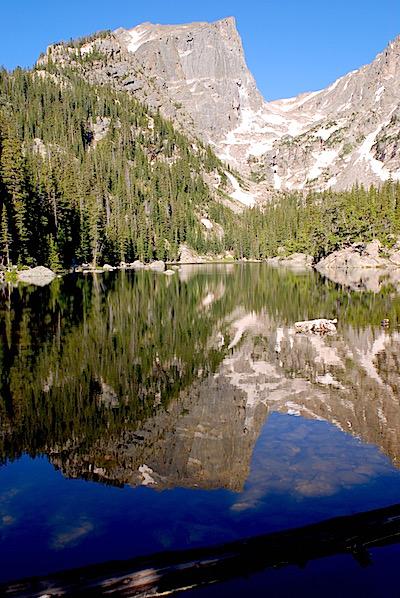
Enjoying this view of Hallet Peak will cost a bit more for many Rocky Mountain National Park visitors after October 1/Kurt Repanshek
Perhaps in a nod to Rocky Mountain National Park's centennial celebration this year, park officials are raising entrance fees, but not until October 1, with higher camping fees arriving in 2016.
On October 1 the fees to get into Rocky Mountain will go up a bit to help fund maintenance and improvement projects within the park. Because of Rocky’s proximity to the populated Colorado Front Range, the park will be adding a single day pass to the existing option of fees. This “Day Use Pass” will be $20, while the weekly pass will increase to $30 for those visitors who intend to enjoy the park for multiple days. The annual park pass will increase to $50 and eventually increase to $60 by 2017. Campground fees will increase to $26 a night in 2016. Campground fees are based on comparable fees for similar services in nearby campgrounds.
“We are committed to keeping Rocky Mountain National Park affordable and we also want to provide visitors with the best possible experience,” said Superintendent Vaughn Baker. “We feel this modest fee increase is still an incredible value when considering other family and recreational experiences one can enjoy. Plus, 80 percent of those funds stay right here in Rocky to benefit visitors. As we celebrate Rocky’s Centennial, these funds will be critical as we move forward into the next 100 years.”
While basic operations of the park are funded by direct appropriations from Congress, the fee program is intended to provide for various enhancements to visitor services and facilities.
Entrance fees have supported a wide range of projects that improve the park and visitor experiences, including renovating all campground restroom facilities, rehabilitating and maintaining approximately 100 of the park’s 350 miles of trails, replacing trailhead signs, replacing picnic tables throughout the park, mitigating hazard trees in or near park facilities such as campgrounds, parking lots, road corridors and visitor centers, and operating the park’s visitor shuttle bus system.
In the fall of 2014, the National Park Service conducted a nationwide review of entrance fees. Rocky Mountain National Park staff solicited public input beginning in October 2014. During the public comment period, the park received 95 formal comments that were related to the park’s proposed fee changes. Based on comments received, there was significantly more support for the proposed fee rate changes than opposed, according to park officials. They said park visitors seem to be highly supportive of fees in general and making the connection with the park’s effort in providing tangible benefits to visitors through fee revenue.
The Federal Lands Recreation Enhancement Act is the legislation under which the park currently collects entrance and amenity fees. This law allows parks to retain 80 percent of the fees collected for use on projects that directly benefit visitors. The remaining 20 percent is distributed throughout the National Park System. Since the beginning of FLREA and its predecessor program Fee Demo, the park has spent over $66 million in repairs, renovations, improvements and resource restoration.
In January 2005, Rocky Mountain National Park was the last of the larger size parks in the Intermountain Region to adopt the $20 per vehicle weekly rate. That same year the annual pass increased to $35, and to $40 in 2009, the last year of any increase in fees.



Add comment